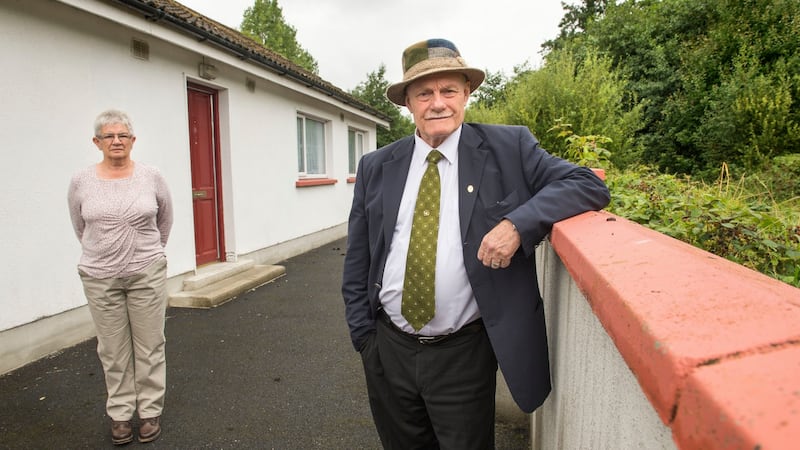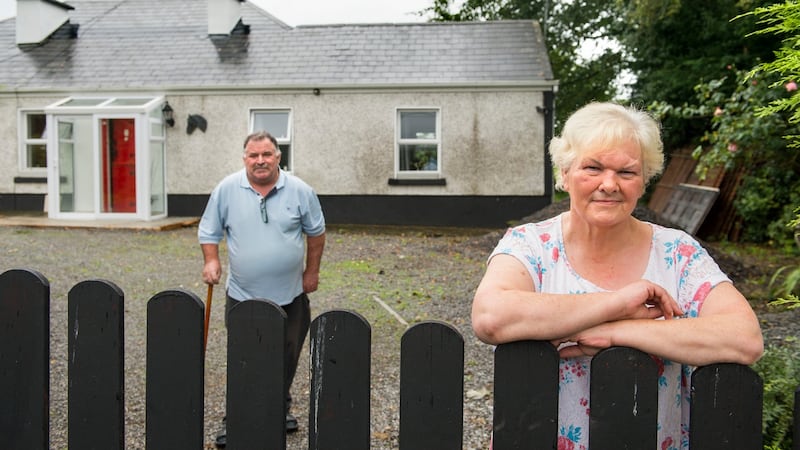Paddy Kavanagh and his wife, Pat, spent much of last Christmas in a hotel, after flood water and raw sewage flowed into their home at Carrickobrien, a short distance from Athlone town, Co Westmeath.
Paddy, who is in his 70s, is angry that despite the turmoil suffered by so many people last year, there appears to have been no work done on the river Shannon since then.
“We had to leave the house where we had lived for the past 35 years as it was up to a depth of five inches of water and there was raw sewage floating in our house. All our wooden floors and carpets were destroyed.”


Nine months on, he says, “The authorities have not learned a solitary lesson. There seems to be a lot of talk but no action.”
Paddy is fearful the floods will hit again this winter and force him from his home.
“We are doomed and marooned. There is a lot of fear, a lot of concern that there has been no action. The flood will come again. If it doesn’t come this year it will come again soon,” says Paddy.
“There is no prospect of anything being done to stop the water coming into our house,” he says.
Paddy, who is a member of the Mid Shannon Flood Relief Group, says his message is simple: "Get the river Shannon lowered to levels it was 40 to 50 years ago. It's as simple as that."
Fear and dread
Paddy is not alone. Dozens of families in the Athlone and surrounding areas are living with the same fear and dread. Winter is approaching and this brings haunting memories of last year.
Memories of water seeping into homes and taking over farm sheds, countless sand bags, water pumps, tractors and transport boxes to bring people around and, for many, weeks living in local hotels.
Imelda Joyce and her husband, Liam, were forced to leave their home in Clonbonny, just outside Athlone, early in January after they lost their battle with flood water.
They spent three months in a local hotel before they returned to their home which had to be extensively renovated due to damage caused by floodwaters.
“I am terrified it will happen again. I’m terrified now when I see the rain. We are living in fear,” Imelda says.
“I don’t think mentally, physically or financially I would be able to go through it again.”
While Imelda and Liam did receive financial support from the Government, “money doesn’t compensate for the damage”, she says.
Like Paddy, Imelda is concerned there are no signs that improvements have been made since last winter.
“To me there is nothing being done and it’s going to be the same again this year. This can’t continue.”
Mayor of Athlone Cllr John Dolan is a farmer in Fardrum, 6km east of Athlone.
He is acutely aware of the fears among local residents which he says are realistic and he is perturbed progress has been all too slow.
“The Shannon level is fairly high even at the moment, higher than it was this time last year,” he says.
“There is definite fear about what is going to happen in the winter. I don’t see any work happening this year.”
He says that dredging on the Shannon would make a huge difference, but he is concerned that this appears to have been ruled out, on environmental grounds, in a draft Catchment Flood Risk Assessment and Management report.
Report
The draft report is on display in Athlone with the public invited to make submissions before September 23rd.
Among the recommendations are the construction of flood defence walls, embankments and floodgates.
Office of Public Works (OPW) engineer John Martin says that the report covers 300 areas, including 66 in the Shannon area.
“The report is very much focusing on flood risk and what sort of work we can put forward to manage those risks,” he says. “We need to look at the full economic and environmental aspects.”
Mr Martin says that schemes will be ranked in terms of priority and much of the work will be done over the next “five to 10 years”.
He says Athlone is an area that’s likely to be moving soon because of the flooding last winter.
Residents in Clonown, a farming stronghold 8km southwest of Athlone, are anxious that their area is top of the priority list. It was one of the worst affected in the country, both during last year’s flood and in 2009.
Up to a dozen families were forced to leave their homes last winter, lands and sheds were badly flooded and roads were blocked.
This meant detours and an additional 16km round-trip daily for hundreds of local residents.
One resident, Padraig Flynn, is astounded that nothing appears to have changed, despite the huge struggles experienced by so many last year.
“People are annoyed that nothing has been done. Nothing has moved forward. The land is okay at the moment but there are fears of what is down the road.”
He acknowledges there has been work in the background, but real progress on the ground is what is desired.
“The co-ordinated approach [which was called for during the flood battles] hasn’t developed. It is split every way. There is a fear about land, property and older people. People who used not be fearful about it are worried now.”
Mr Flynn says residents are concerned the ESB does not appear to have been proactive since the flooding.
In response, the ESB says that it is a member of the Shannon Flood Risk State Agency Co-Ordination Working Group, which was set up by the Government in the aftermath of last winter's flooding, and it has attended the group meetings since its formation.
In relation to Clonown and the area downstream of Athlone, the ESB said it “exercises some control over the water levels in Lough Ree during non-flood periods through the operation of the sluice gates at Athlone weir.
Downstream flooding
“These are operated to maintain minimum navigation levels in the lake during the summer period and, where possible, minimise downstream flooding in the Callows areas.
"ESB co-operates closely with Waterways Ireland in the operation of these sluice gates. However, the lake level and the level in the Callows is naturally very dependent on rainfall," a spokeswoman for the ESB said.
The Irish Farmers’ Association held a protest in Athlone on Tuesday during which association president Joe Healy called on the Government to set out an immediate plan of action and timelines for work to prevent further flooding.
Westmeath County Council said it was doing its best to alleviate flooding, but that it was a lengthy process.
Pat Keating, the acting director of services with the council, said this week that if there was a similar flood again this year, "We will be in the same boat. We will have to make the same response."
However, he anticipates huge progress within the next two years. A consultant has been engaged by the council, he says, to start the process which would lead to a detailed design, planning and procurement process for major works.
The council is hopeful that work will get under way next summer.
Permanent features
In the long-term, Mr Keating says what was needed was “embankments and flood walls as permanent features. That’s what the sandbags did the last time.”
Some minor localised works have been identified and will be carried out in the short-term, he adds, including installing non-return valves to shut off the water and installing pumps on the streets in the areas affected.
“We feel that that work can be done this year. This will take some of the pressure away and will improve the situation, but there isn’t a magic wand,” says Mr Keating.
“By December next year, we will have some of our defences in place. I’d say we won’t have to worry about defences by December 2018.”
Local Independent TD Kevin “Boxer” Moran, who was elected to the Dáil for the first time in March after making flooding an issue on the campaign trail, is likely to feel the heat locally if there is not swift action on flood defences.
He is one of the Independent TDs supporting the Government who lost a “coin toss” with Minister of State for the OPW Seán Canney as to who would serve as Minister first.
He claimed a lot of work is going on behind the scenes and has promised an announcement within weeks, which he said would speed up the work on the Shannon.
“It’s only nine weeks since the Government was formed. Seán [Canney] and I are working very closely together. We are making good progress. We are looking at lowering the levels of the Shannon.”
He added: “We are hoping to make an announcement the week after next, about lowering the levels of the Shannon. The money is there. If we can lower the levels, it’s a step in the right direction.”
Mr Moran said he is confident that work on permanent structures, aimed at alleviating flooding in the Shannon catchment area in the long-term, will start in Athlone early in 2017. Red tape, he said, is slowing down the process.
“The red tape is preventing things from happening faster. We are trying to speed things up.”
Too slow
Mr Canney says work is progressing, but accepts it is all too slow. “We have the money. I want to crank up expenditure from €50 million at the moment to €100 million in two years’ time. We want to get as much done in the next two years as possible.
“We are looking at dropping the levels as much as they can be dropped to prevent flooding.
“We can do small things such as embankments and barriers and using bogs over winter to keep the levels of the river lower that don’t cost money. I am trying to do some practical measures.
“5,000 properties across the country have been protected since 2009 due to minor works schemes.
“In the short-term I won’t raise anybody’s hopes and say it will be done, but if we can keep levels down that will help. There are things happening.
“€50 million will be spent this year, but we won’t get to every place. I’m trying to get things done faster,” says Mr Canney.










